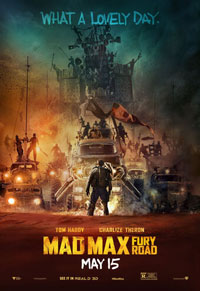(January 20-26)
The novel has been going gangbusters this week: I’ve beaten last week’s impressive 3,000 word spree by a clear 1,000 words (while also fitting in an additional thousand-word chunk of editing on the way).
I’m particularly gratified by this progress because it’s on the same chapter I stalled on—and ended up abandoning—last year. Turns out that swapping the offending chapter with the one that originally came after it has really helped it to find its place in the novel. It’s almost writing itself now.
I’m hoping I can wrap up the first draft of this chapter next week and then move on to a brand new chapter (scary/exciting). However, I’ll just be happy writing what I can while my start-of-year motivation is still firing away.
One good thing

I rewatched Mad Max: Fury Road with the Elderbeast over the weekend. It remains awesome: a truly balls to the wall road movie actioner, which also does a great job of putting its characters through a compelling emotional journey.
One of the things I admire most about this movie (other than the incredible blend of directing, editing and cinematography that makes the action sequences all but rip themselves out of the screen) is the minimal dialogue. For starters, our title character barely speaks during the first act. He’s barely a person—a presence: forcibly injected into a story that’s already happening (in fact, he’s a passenger in someone else’s story, but this is the way of all but the first of the Mad Max movies). Sure, there’s exposition later in the movie, but the vast share of the story is communicated through action and the audience just has to buckle in and stay along for the ride.
Even the main character of the movie, Furiosa (played to excellence by Charlize Theron), purposefully speaks only when necessary. Those around her are expected to follow her lead, not her instructions.
Interestingly, the characters who do the most talking are the ones trying to maintain the apocalyptic status quo, alongside their unquestioning devotees who have developed a faith built, in large part, upon packaged, repetitive mantras and other verbal symbology.
Conversely, it’s telling that Max grows more communicative as the movie progresses. He begins (in his own words, ironically) as a broken man driven to survive for survival’s sake. However, by the end of the movie he sees a chance to redeem himself for failing all the others that were left behind. This requires him to communicate; to interact with those around him.
So what have I learned from this? For starters, this is a story that could almost certainly only work on the screen. Sure, you could do it as a graphic novel but I suspect the non-stop action panels would cease engaging the eye after a few pages. More, it’s an example of how silence can be used to build character—easier to achieve in a visual medium. Finally, it’s yet another good example of how stripping exposition to the bone can be the prompt that forces you to devise even more inventive ways of communicating what your story is.
One bad thing
One of the things I have struggled with over the last several years is that I’m not a very good reader. I find it hard to get into books, but very easy to get distracted and wander off towards other pursuits. As a consequence, I find I don’t read anywhere near as much as I need to, or even as much as I want to.
A small part of the problem is my nightly routine (spoiler: I only read at bedtime so this routine is a rather critical contributor towards my reading habits). I go to bed; I catch up on the various blogs that I subscribe to; and then I read. You might see the problem right away.
Catching up on blogs can sometimes take just a few minutes, or it can end up being a 20 minute rabbit hole at the bottom of which I’m suddenly too tired to read (or my brain is still expecting that constant zap-zap influx of information, and is no longer in the best frame for digesting a single, lengthy narrative).
The potential answer is simple: read first and browse later (and if I’m too tired to browse afterwards, well those posts aren’t going anywhere). I’ve managed to do it a couple of times this week, but it’ll take time to make it a habit. Hopefully the difference will start showing in my reading list for 2020.
